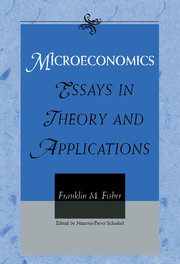Book contents
- Frontmatter
- Contents
- Introduction
- Part I Disequilibrium and Stability
- 1 The Formation of Economic Magnitudes: Disequilibrium and Stability (1990)
- 2 Quasi-Competitive Price Adjustment by Individual Firms: A Preliminary Paper (1970)
- 3 Stability and Competitive Equilibrium in Two Models of Search and Individual Price Adjustment (1973)
- 4 On Price Adjustment without an Auctioneer (1972)
- 5 Quantity Constraints, Spillovers, and the Hahn Process (1978)
- 6 On Stability Analysis with Disequilibrium Awareness (1988)
- 7 It Takes t* to Tango: Trading Coalitions with Fixed Prices (1989)
- 8 An Alternate Proof and Extension of Solow's Theorem on Nonnegative Square Matrices (1962)
- 9 Choice of Units, Column Sums, and Stability in Linear Dynamic Systems with Nonnegative Square Matrices (1965)
- 10 A Simple Proof of the Fisher–Fuller Theorem (1972)
- 11 Gross Substitutes and the Utility Function (1972)
- Part II Welfare Economics and Consumer Theory
- Part III Applications of Microeconomic Theory
- Part IV Industrial Organization, Economics, and the Law
- Part V Public Policy Applications
- Epilogue
- Indexes
5 - Quantity Constraints, Spillovers, and the Hahn Process (1978)
Published online by Cambridge University Press: 20 March 2010
- Frontmatter
- Contents
- Introduction
- Part I Disequilibrium and Stability
- 1 The Formation of Economic Magnitudes: Disequilibrium and Stability (1990)
- 2 Quasi-Competitive Price Adjustment by Individual Firms: A Preliminary Paper (1970)
- 3 Stability and Competitive Equilibrium in Two Models of Search and Individual Price Adjustment (1973)
- 4 On Price Adjustment without an Auctioneer (1972)
- 5 Quantity Constraints, Spillovers, and the Hahn Process (1978)
- 6 On Stability Analysis with Disequilibrium Awareness (1988)
- 7 It Takes t* to Tango: Trading Coalitions with Fixed Prices (1989)
- 8 An Alternate Proof and Extension of Solow's Theorem on Nonnegative Square Matrices (1962)
- 9 Choice of Units, Column Sums, and Stability in Linear Dynamic Systems with Nonnegative Square Matrices (1965)
- 10 A Simple Proof of the Fisher–Fuller Theorem (1972)
- 11 Gross Substitutes and the Utility Function (1972)
- Part II Welfare Economics and Consumer Theory
- Part III Applications of Microeconomic Theory
- Part IV Industrial Organization, Economics, and the Law
- Part V Public Policy Applications
- Epilogue
- Indexes
Summary
Introduction
In recent years there has been considerable interest in general equilibrium (or disequilibrium) models in which agents perceive that they cannot complete their desired transactions and hence choose their demands by optimizing subject to quantity constraints on their trading activity. [Examples are Clower (1965), Patinkin (1965), Leijonhufvud (1968, 1973), Barro and Grossman (1971), Benassy (1975, 1976, multilith, forthcoming), Frevert (1970), Hayashi (multilith), Varian (April 1975, April 1977), and Veendorp (1975).] Such constraints affect not only the markets in which they occur, but they also “spill over” in their effects on other markets because they can alter demands for all goods. The leading case, of course, is that in which the realization of unemployment affects demands by consumers, and, indeed, much of the literature has concentrated on such phenomena as an explanation for the existence of Keynesian underemployment equilibria. However, the phenomenon involved can be much more general, and one should expect that it leads to equilibria that are not Walrasian (competitive) in a general model as quantity-constrained demands all get satisfied. [Probably the most satisfactory proofs of existence are those of Benassy (1975, 1976, multilith, forthcoming).]
Despite the fact that the subject is one of disequilibrium behaviour, however, most of the work has concentrated on showing the existence of such non-Walrasian equilibria and relatively little is known about the dynamic stability of adjustment processes in such models. Such analyses as are available [e.g. Frevert (1970), Hayashi (multilith), Varian (April 1975, April 1977), and Veendorp (1975)] typically involve relatively simple models or very strong restrictions of the gross substitute type.
Information
- Type
- Chapter
- Information
- MicroeconomicsEssays in Theory and Applications, pp. 110 - 129Publisher: Cambridge University PressPrint publication year: 1999
